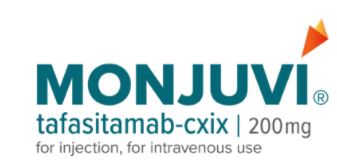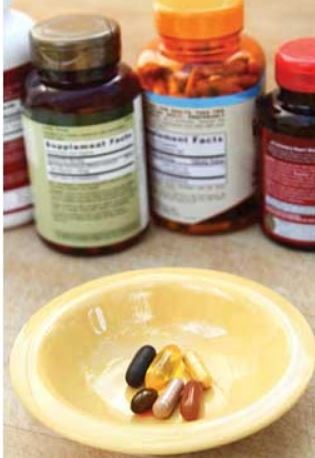
MONJUVI® (tafasitamab-cxix) for injection
Morphosys Inc
INDICATION: in combination with lenalidomide, is indicated for the treatment of adult patients with relapsed or refractory diffuse large B-cell lymphoma (DLBCL) not otherwise specified, including DLBCL arising from low grade lymphoma, and who are not eligible for autologous stem cell transplant (ASCT).
MECHANISM OF ACTION: Tafasitamab-cxix is an Fc-modified monoclonal antibody that binds to CD19 antigen expressed on the surface of pre-B and mature B lymphocytes and on several B-cell malignancies, including DLBCL, mediates B-cell lysis through apoptosis and immune effector
mechanisms
EFFICACY:
- Open label, multicenter single-arm trial, n=81 patients with a diagnosis of DLBCL
- Endpoint: Overall response rate (ORR), defined as complete and partial responders and response duration
- Best ORR : 55% (95% CI: 43%, 67%), complete responses in 37%, partial responses in 18%, median response duration was 21.7 months (range: 0, 24)
SAFETY: The most common adverse reactions (≥20%) were neutropenia, fatigue, anemia, diarrhea, thrombocytopenia, cough, pyrexia, peripheral edema, respiratory tract infection, and decreased appetite.
REGULATORY PATHWAY:
- Accelerated approval based on ORR, one month ahead of the FDA goal date.
- Continued approval contingent upon verification and description of clinical benefit in a confirmatory trial(s)
- Review used the Assessment Aid, a voluntary submission from the applicant to facilitate the FDA’s assessment
- Priority review, fast track, breakthrough, and orphan product designation

TECARTUS™(brexucabtagene autoleucel) suspension for
intravenous infusion
Kite Pharma
INDICATION: CD19-directed genetically modified autologous T cell immunotherapy indicated for the treatment of adult patients with relapsed or refractory mantle cell lymphoma (MCL)
MECHANISM OF ACTION: Binds to CD19-expressing cancer cells, activate downstream signaling cascades that lead to T cell activation, proliferation, acquisition of effector functions , and
secretion of inflammatory cytokines and chemokines and to killing of CD19-expressing cells
EFFICACY:
- Open-label, multicenter, single-arm trial, n=74 patients with relapsed or refractory MCL with prior therapy
- Primary efficacy outcome measure: Objective response rate (ORR) based on a minimum duration of follow-up for response of six months
- ORR was 87% (95% CI: 75, 94), with a complete remission (CR) rate of 62% (95% CI: 48, 74)
- Of all 74 leukapheresed patients, ORR was 80% (95% CI: 69, 88) with a CR rate of 55% (95% CI: 43, 67)
SAFETY:
- Boxed Warning : Cytokine release syndrome and neurologic toxicities with a with a Risk Evaluation and Mitigation Strategy
- Most common Grade 3 or higher reactions: Anemia, neutropenia, thrombocytopenia, hypotension, hypophosphatemia, encephalopathy, leukopenia, hypoxia, pyrexia, hyponatremia, hypertension, infection – pathogen unspecified, pneumonia, hypocalcemia, and lymphopenia
REGULATORY PATHWAY:
- Accelerated approval based on ORR and durability of response; continued approval contingent upon verification and description of clinical benefit in confirmatory trial
- Orphan drug designation, breakthrough therapy designation, and priority review

Epidiolex (cannabidiol) [CBD] oral solution
Greenwich Biosciences Inc.
INDICATION: Treatment of seizures associated with tuberous sclerosis complex (TSC) in patients one year of age and older
ADDRESSING UNMET NEED: Only FDA-approved drug that contains a purified drug substance derived from cannabis. It is also the second FDA approval of a drug for the treatment of seizures associated with TSC
- TSC is a rare genetic disease causing non-cancerous (benign) tumors to grow in the brain and other parts of the body like the eyes, heart, kidneys, lungs, and skin
- Affects about 1 in 6,000 people
MECHANISM OF ACTION: CBD is a chemical component of the Cannabis sativa plant. However, CBD does not cause intoxication or euphoria (the “high”) that comes from tetrahydrocannabinol (THC). Precise mechanism of anticonvulsant effect is unknown
EFFICACY & SAFETY:
- Randomized, double-blind, placebo-controlled trial, n=224
- Primary endpoint: Change from baseline in seizure frequency
- Significantly greater reduction in the frequency of seizures with Epidiolex
- Effect seen within eight weeks; consistent throughout the 16-week treatment period
- Dispensed with patient Medication Guide with drug’s uses and risks
- Most serious risks: Increase in suicidal thoughts and behavior, or thoughts of self-harm
- Most common side effects: diarrhea, elevated liver enzymes, decreased appetite, sleepiness, fever, and vomiting
- Additional side effects: liver injury, decreased weight, anemia, and increased creatinine
REGULATORY PATHWAY: Supplemental NDA
- FDA supporting rigorous scientific research on the potential medical uses of cannabis-derived products and working with product developers who are interested in bringing patients safe and effective, high quality products
- Previously approved for treatment of seizures associated with two rare and severe forms of epilepsy, Lennox-Gastaut syndrome (LGS) and Dravet syndrome (DS)
- Not a controlled substance

VILTEPSO (viltolarsen) injection
NS Pharma
INDICATION: Treatment of Duchenne Muscular Dystrophy (DMD) in patients who
have a confirmed mutation of the DMD gene that is amenable to exon 53 skipping
ADDRESSING UNMET NEED: DMD is a rare genetic disorder characterized by progressive muscle deterioration and weakness caused by mutations in the DMD gene that results in an absence of dystrophin. First symptoms are usually seen between three and five years of age and worsen over time. Occurs in approximately one out of every 3,600 male infants worldwide; in rare cases, it can affect females.
MECHANISM OF ACTION: Binds to exon 53 of dystrophin pre-mRNA resulting in exclusion of this exon during mRNA processing. Exon 53 skipping allows production of an internally truncated dystrophin protein in patients with genetic mutations that are amenable to exon 53 skipping
EFFICACY AND SAFETY:
- 2 clinical studies, n=32 patients with genetically confirmed DMD
- Dystrophin levels increased, on average, from 0.6% of normal at baseline to 5.9% of normal at week 25
- Increase in dystrophin production is reasonably likely to predict clinical benefit
- Most common side effects: Upper respiratory tract infection, injection site reaction, cough and fever; kidney toxicity, including potentially fatal glomerulonephritis, has been observed after administration of some antisense oligonucleotides- function should be monitored
REGULATORY PATHWAY: NDA
- Accelerated approval; based on an increase in dystrophin production in skeletal muscle -continued approval contingent upon verification and description of clinical benefit

EVRYSDI™ (risdiplam) for oral solution
Genentech
INDICATION: Treatment of Spinal Muscular Atrophy (SMA) in patients 2 months
of age and older
ADDRESSING UNMET NEED: SMA is a rare and often fatal genetic disease affecting muscle strength and movement; second drug and the first oral drug approved to treat disease
MECHANISM OF ACTION: Increases exon 7 inclusion in survival of motor neuron 2 (SMN2) messenger ribonucleic acid (mRNA) transcripts and production of full-length SMN protein in the brain
EFFICACY & SAFETY:
- Open-label, infantile-onset SMA study, n= 21 patients, average age 6.7 mo., 12 mo. treatment
- Efficacy endpoint: Ability to sit without support for at least 5 sec and survival without permanent ventilation vs. natural progression of the disease
- Meaningful improvement with 41% patients able to sit independently, 81% of patients were alive without permanent ventilation
- Second randomized, placebo-controlled study, n=180 patients with later-onset SMA, age 2-25 yrs
- Efficacy endpoint: Change from baseline in MFM32 (a test of motor function) total score at 1 yr; 1.36 increase in score with EVRYSDI vs. 0.19 decrease on placebo
- Most common side effects: Fever, diarrhea, rash, ulcers of the mouth area, joint pain (arthralgia) and urinary tract infections
- Additional side effects for the infantile-onset population: Upper respiratory tract infection, pneumonia, constipation and vomiting
REGULATORY PATHWAY: NDA
- Fast track designation, priority review, orphan drug designation, Rare Pediatric Disease Priority Review Voucher

Hangover Remedies
Warning letters to seven companies whose products claim to cure, treat, mitigate, or prevent hangovers
- Alcohol intoxication, a poisoning, causes dose-related dysfunction and damage, ranging from mild impairments to death
- Products from these companies, labeled as dietary supplements, are unapproved new drugs and have not been evaluated by the FDA to be safe and effective for their intended use
Warning letters were sent to the following companies:
- Double Wood LLC
- Ebnsol Inc.
- Vita Heaven, LLC dba Hangover Heaven
- Happy Hour Vitamins
- LES Labs
- Mind, Body & Coal LLC
- Purple Biosciences LLC
Image credits: FDA, Morphosys, Kite, Greenwich, NS Pharma, Genentech